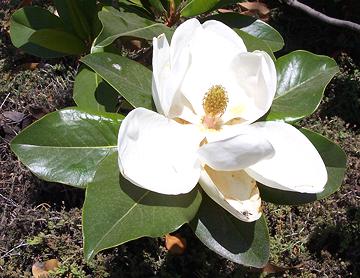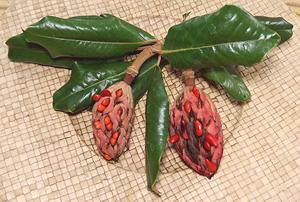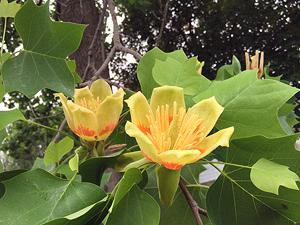Magnolias & Tulip Trees
 [Genus Magnolia | Genus Liriodendron
(Tulip Trees) - both of Family Magnoliaceae]
[Genus Magnolia | Genus Liriodendron
(Tulip Trees) - both of Family Magnoliaceae]
Magnolias are a very ancient line and are thought to be the first fully
developed flowering land plants from which all others descend. The
flowering plants we depend on for food and flavorings were formerly given
the name Magnoliophyta, but in the era of the AGP they have been
renamed to Angiosperms.
The Magnolias themselves are noted mainly for popular decorative
flowering trees. Some also provide high quality wood, and medicinals,
but culinary usage is very local. There are at least 254 species in this
genus.
More on Magnoliids.
 The photo to the left is of mature Magnolia Fruits (M. grandiflora)
that have developed from the central spike in the flowers. The fruit is very
hard, and the central flower spike that develops into the fruit is also quite
hard. The Magnolias developed long before there were bees, and depended on
beetles for fertilization. The beetles were much more interested in eating
the flowers than fertilizing them, so the flowers had to be tough. The photo
specimen was picked up after a wind storm in Los Angeles, California.
The photo to the left is of mature Magnolia Fruits (M. grandiflora)
that have developed from the central spike in the flowers. The fruit is very
hard, and the central flower spike that develops into the fruit is also quite
hard. The Magnolias developed long before there were bees, and depended on
beetles for fertilization. The beetles were much more interested in eating
the flowers than fertilizing them, so the flowers had to be tough. The photo
specimen was picked up after a wind storm in Los Angeles, California.
Cooking
Japan:
Flower buds and young leaves of M. hypoleuca
and M. obovata are cooked as a vegetable, while older leaves are
ground to a powder as a seasoning. Whole dried leaves are also used as
dishes to hold a stuffing for broiling. One variety of Miso (hoba miso) is
flavored with Magnolia.
Asia:
Magnolia flower buds are used to flavor rice and and
scent tea.
China:
Dried buds and petals of M. biondii are used
as flavorings in some regions. Fresh flower buds are pickled with vinegar
and ginger. Fresh petals are coated with a flour batter and deep fried.
Mexico, Central America:
The main uses of M. mexicana
are medicinal, but fresh flowers are also used in culinary preparations, and
fresh leaves are used as a flavoring.
England:
Magnolias have been imported from North America.
Petals of M. grandiflora are pickled and used as a spicy condiment.
Tulip Tree
 [Genus Liriodendron of Family Magnoliaceae]
[Genus Liriodendron of Family Magnoliaceae]
The Tulip Tree flowers are structured just like the Magnolia flowers, with a
similar central spike that develops into the fruit. To the best of my
knowledge no part of the Tulip Tree is eaten, but the fine grained wood is
quite liked and sold as "Yellow Poplar". The photo was taken in New Jersey,
USA where Tulip Trees are native, but they have been introduced as far as
Oregon.
Photo by Famartin distributed under license Creative Commons
Attribution-ShareAlike v4.0 International.
mn_magnolz.html 220703 - www.clovegarden.com
©Andrew Grygus - agryg@clovegarden.com - Photos on this
page not otherwise credited are © cg1 -
Linking to and non-commercial use of this page permitted
 The photo to the left is of mature Magnolia Fruits (M. grandiflora)
that have developed from the central spike in the flowers. The fruit is very
hard, and the central flower spike that develops into the fruit is also quite
hard. The Magnolias developed long before there were bees, and depended on
beetles for fertilization. The beetles were much more interested in eating
the flowers than fertilizing them, so the flowers had to be tough. The photo
specimen was picked up after a wind storm in Los Angeles, California.
The photo to the left is of mature Magnolia Fruits (M. grandiflora)
that have developed from the central spike in the flowers. The fruit is very
hard, and the central flower spike that develops into the fruit is also quite
hard. The Magnolias developed long before there were bees, and depended on
beetles for fertilization. The beetles were much more interested in eating
the flowers than fertilizing them, so the flowers had to be tough. The photo
specimen was picked up after a wind storm in Los Angeles, California. [Genus Magnolia | Genus Liriodendron
(Tulip Trees) - both of Family Magnoliaceae]
[Genus Magnolia | Genus Liriodendron
(Tulip Trees) - both of Family Magnoliaceae]
 [Genus Liriodendron of Family Magnoliaceae]
[Genus Liriodendron of Family Magnoliaceae]